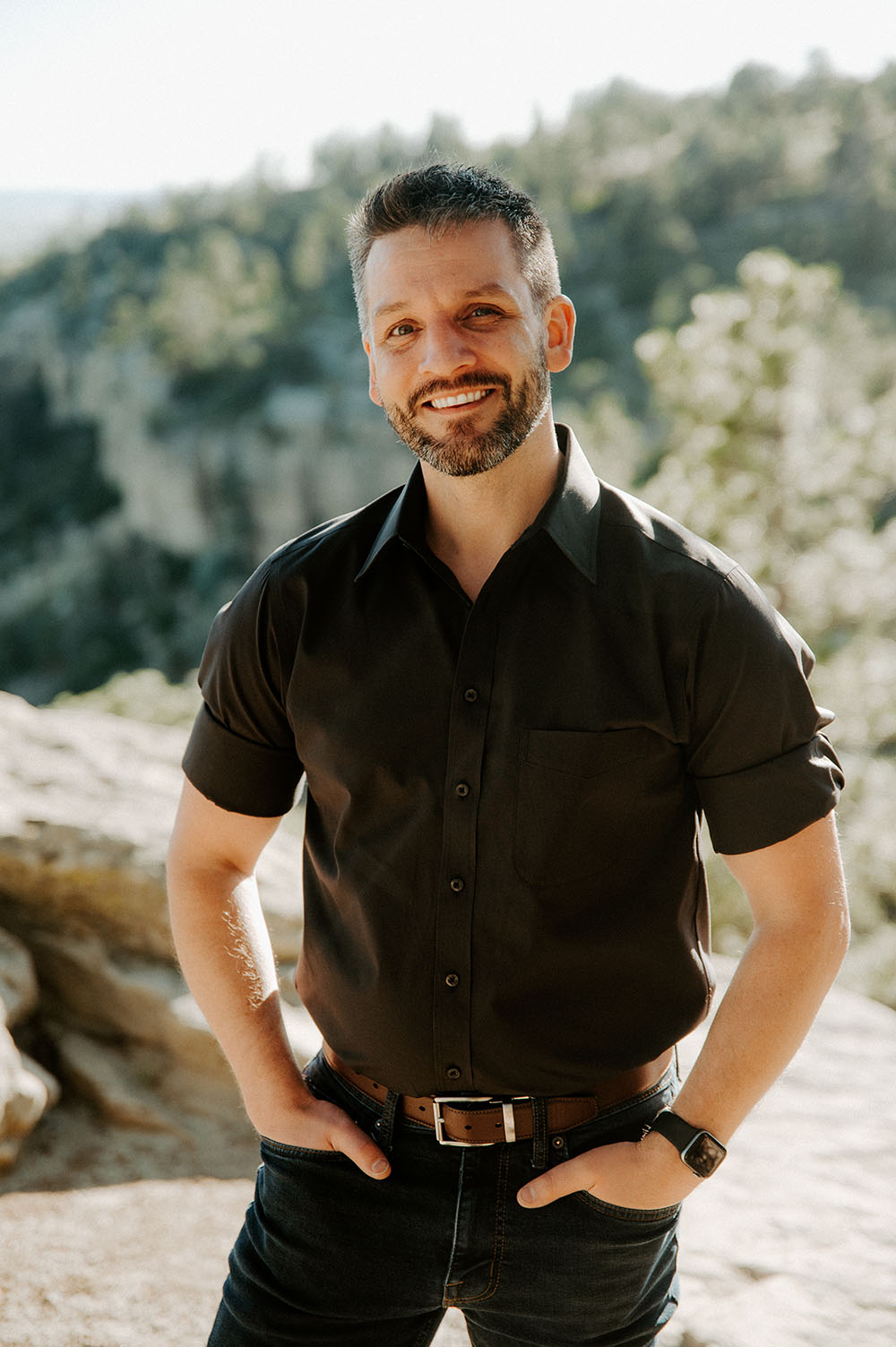A Philosophy of Collaboration
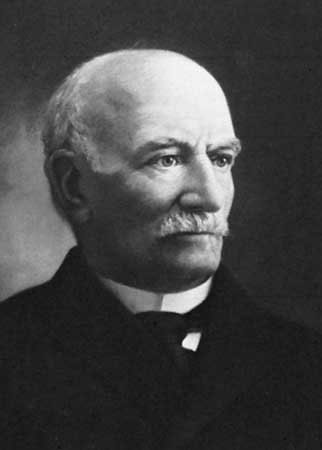
William Worrall Mayo, M.D. (1819-1911)
Courtesy of Mayo Clinic
“As we men of medicine grow in learning we more justly appreciate our dependence upon each other. The sum total of medical knowledge is now so great and wide spreading that it would be futile for any one man…to assume that he has even a working knowledge of any large part of the whole. The very necessities of the case are driving practitioners into cooperation. The best interest of the patient is the only interest to be considered, and in order that the sick may have the benefit of advancing knowledge, union of forces is necessary”
- William J. Mayo, M.D., son of William Worrall Mayo, M.D.; commencement address to the Rush Medical College Class of 1910.
In the PBS documentary The Mayo Clinic: Faith—Hope—Science by Ken Burns and the Ewers brothers, these are the first words you’ll hear narrated by Tom Hanks. A powerful opening to one of the most inspiring documentaries I’ve seen.
After watching this documentary, I was inspired to publish an essay with the following purpose: To establish collaboration as a philosophy that can guide the entire dental team successfully through the challenges of restorative dentistry. I will draw primarily from the Ken Burns documentary and other published sources about Mayo Clinic. I cannot overstate the benefit of watching the documentary yourself.
Mayo Clinic specialists reviewed this article for factual accuracy about the history of Mayo Clinic. The opinions drawn from these facts are my own and do not represent or constitute an endorsement from Mayo Clinic.
Part 1: A Legacy of Collaboration
William Worrall Mayo was born in Salford, near Manchester, England, on May 31 1819. His father, a skilled cabinet maker, died when W.W. Mayo was 7 years old. The young man became a protégé of John Dalton, the famous British meteorologist, chemist and pioneer in development of the atomic theory. Dalton was committed to the scientific method, the merits of hard work rather than the privileges of birth and many aspects of social justice. While it is impossible to determine precise degrees of influence, there is no question that W.W. Mayo demonstrated these qualities throughout his life. Needing to make his way in the world and good with his hands, young Mayo finished studying with Dalton and began work as a tailor, presaging his future career as a surgeon.
W.W. Mayo immigrated to the United States in 1846. His first job was as a chemist at Bellevue Hospital in New York City, which began his transition to the field of medicine. He left the hospital just in time to avoid a typhus epidemic. He ultimately made his way to Indiana and enrolled at the Indiana Medical College in La Porte, where he graduated in 1850 and married Louise Abigail Wright in 1851. Dr. and Mrs. Mayo represented an early example of collaboration. Capable and practical, Louise Mayo managed the family finances and advised patients when her husband was traveling. She even ran a millinery business to augment their income, since it was difficult for Dr. Mayo to make a living on the western frontier. As the Ken Burns documentary explained, “No matter where he went, there were either too many doctors or not enough patients. He worked as a surveyor, riverboat pilot, newspaper publisher and veterinarian.” Dr. Mayo’s scope of experience and interest was vast.
During the Civil War, Dr. W.W. Mayo was appointed to be an examining medical officer for the Union Army. This assignment brought him and his family to Rochester, Minnesota, which Mrs. Mayo said would be their last move. Possessed of what his family called “a questing spirit,” Dr. Mayo left home for weeks at a time in the coming years to visit leading surgeons and hospitals in Chicago and on the East Coast, always seeking ways to improve his skills. He loved learning and as early as 1871 began contributing articles to medical journals. He also served in professional and civic organizations. Obviously, Dr. Mayo valued self-education as well as formal education, but became famous for the value he placed on education through collaboration.
Dr. W.W. Mayo and Louise had two sons – William James (Will) and Charles Horace (Charlie) – the Mayo brothers, who later recalled growing up in medicine “the way farm boys are taught to farm.” From an early age, they adopted their father’s philosophy: “No man is big enough to be independent of others.”
Dr. W.W. Mayo set the example of self-sacrifice and personal risk for the sake of the patient. He often journeyed in the dead of winter to deliver a baby, treat farmers who were injured on the job or perform his specialty, an operation for ovarian tumors. He and Louise even mortgaged their family’s home to afford a state-of-the-art microscope that would help his patients.
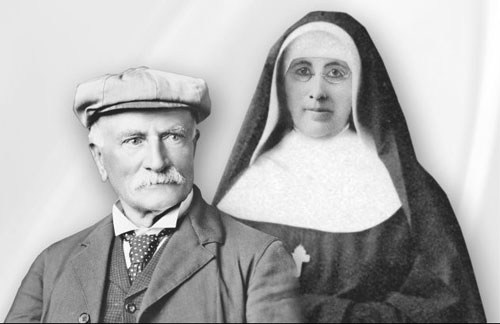
Dr. W.W. Mayo and Mother Alfred Moes. Courtesy of Mayo Clinic.
The individual values of a few figures, given the right time and place, can become imbedded into generations. This is exemplified by Hippocrates, purported author of the Hippocratic Oath, in the 5th Century B.C., who is famously known as the father of medicine. Another such time and place in the history of medicine was in 1883, when a tornado devastated the prairie town of Rochester. This disaster was the unlikely beginning of Mayo Clinic.
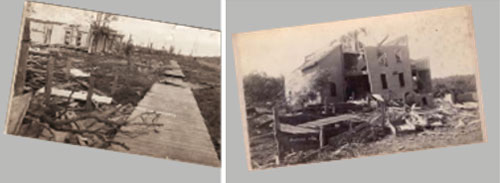
Devastation of the Rochester tornado, 1883. Courtesy of Mayo Clinic.
As the leading physician in town, Dr. W.W. Mayo was placed in charge of organizing relief efforts. His sons, Dr. Will, barely three months after graduating from medical school, and Charlie, a teenager still living at home, assisted him. Needing help, Dr. W.W. Mayo approached Mother Alfred Moes, an immigrant from Luxembourg and founder of the Sisters of St. Francis, who had established a school. A natural leader, she offered room in her school for injured survivors to convalesce and sent some Sisters from her congregation to serve as nurses in the dance hall and other makeshift facilities where Dr. Mayo and his colleagues performed emergency surgery.
The Sisters did their best to care for the injured, not being trained in nursing but as teachers. Dr. W.W. Mayo and Mother Alfred Moes had their first collaboration practicing medicine during duress, a catastrophe. Because of the circumstances, Dr. W.W. Mayo could not afford to belittle the qualifications of anyone who was willing to help. By nature, he recognized the value that even a completely uneducated person can offer to medicine, and how it is through collaboration that much more can be accomplished.
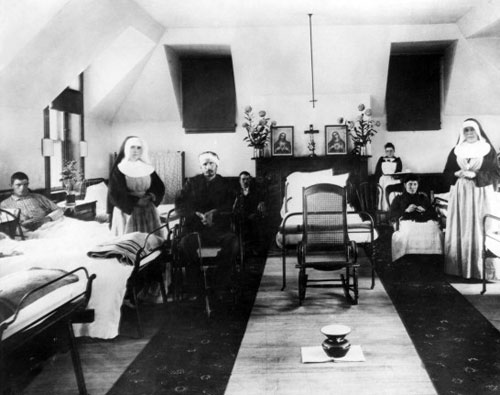
Saint Marys Hospital, Rochester, Minnesota, soon after it opened in 1889. Courtesy of Mayo Clinic.
As the crisis subsided, Mother Alfred visited Dr. W.W. Mayo with a bold offer: The Sisters of St. Francis would raise the funds to build a hospital and serve there as nurses if Dr. Mayo and sons would provide the medical and surgical care. Significantly, Dr. Mayo and Mother Alfred never signed a legal contract. Whether literal or figurative, their “handshake” sealed an agreement based upon mutual trust and respect that is the foundation of Mayo Clinic today. Mother Alfred put her Sisters to work – even using their needlepoint skills – to raise the funds that built Saint Marys Hospital, which opened in 1889. Saint Marys played a key role in the growth of Mayo Clinic. It opened at the dawn of antiseptic surgery, which made operations much safer. Dr. W. W. Mayo’s sons – known as Dr. Will and Dr. Charlie – adopted the latest principles and created innovations of their own, with results that were widely published in the medical literature and popular media. Soon, practitioners were flocking to Rochester to learn and patients were coming to receive care from what was variously nicknamed “the medical mecca” and “the clinic in the cornfield.”
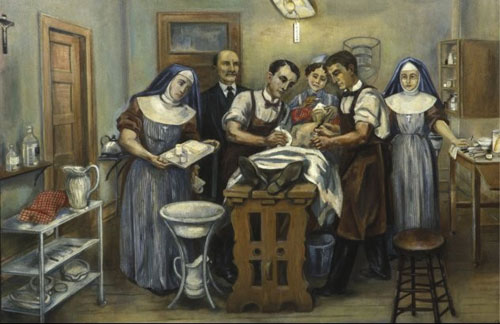
Early surgery at Saint Marys Hospital. Courtesy of Mayo Clinic.
The unconventional pairing of Dr. W.W. Mayo and Mother Alfred Moes cannot be overstated. Dr. Mayo was a man of science who admired Charles Darwin; Mother Alfred was a woman of faith who named her congregation for the Virgin Mary. How and why would a doctor who studied under a famous scientist and a woman who dedicated her life to God work so well together?
As a surgeon in the 19th century, Dr. W.W. Mayo struggled to overcome the complexities of healing. It is true that he began practicing before the discovery of bacteria and sanitation, but even with all the advancements made within his lifetime, he believed that no matter how far science came to addressing the challenges of healing the body, without the mind and spirit, a patient could atrophy regardless.
Dr. W.W. Mayo and the Sisters of St. Francis show that even a personal philosophy can have influence well beyond oneself. His sons are perfect examples of how a philosophy of collaboration can endure.
In their collaboration, Dr. W.W. Mayo and his sons, along with the Franciscan Sisters, aspired to a philosophy of healing that stressed three tenants: Faith, Hope and Science. They believed that it was important to offer care without consideration of the patient’s race, gender, financial means or professed religion. Such an unconventional alliance exemplifies the power of collaboration. As their practice grew, Dr. Will and Dr. Charlie welcomed other specialists as colleagues who worked with them and shared their ideals. Today, there are more than 67,000 employees of Mayo Clinic at locations in Rochester, Minnesota; Jacksonville, Florida; Scottsdale and Phoenix, Arizona; and community-based hospitals and clinics of Mayo Clinic Health System in Minnesota, Iowa and Wisconsin.
Mayo Clinic became a destination for both patients and surgeons. The Mayo brothers took their passion for collaboration so far that they went to great lengths to facilitate it. They designed special viewing platforms and slanted mirrors in the operating room to accommodate the scores of doctors traveling from all over who wanted to see them work. The brothers would share with the crowd of peers where, when and how they had learned a given method. They would often state it was acquired from a visiting doctor such as those witnessing.
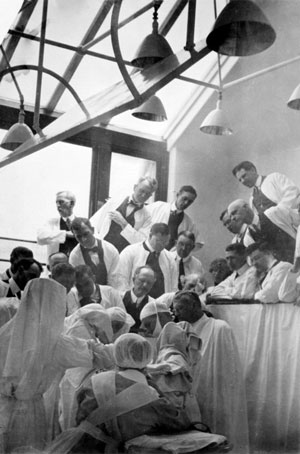 Both Dr. W.W. Mayo and his two sons recognized that the antithesis to collaboration is isolation. All three invested copious amounts of time and money to travel throughout the United States and abroad to bring back the latest methods and technology that modern medicine could provide.
Both Dr. W.W. Mayo and his two sons recognized that the antithesis to collaboration is isolation. All three invested copious amounts of time and money to travel throughout the United States and abroad to bring back the latest methods and technology that modern medicine could provide.
Right and below: Visiting doctors watch surgery at Saint Marys Hospital in the early 1900s.Courtesy of Mayo Clinic.
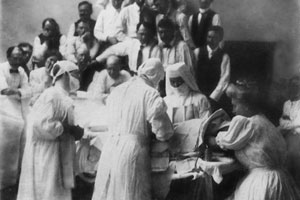
The spirit of collaboration has made it possible for Mayo Clinic to pioneer a wide range of innovations throughout its history. For example:
- Developed and implemented the concept of integrated, multispecialty group practice of medicine. This is Mayo Clinic’s most enduring and significant contribution to medicine.
- Incorporated antisepsis in their surgery with astonishing results: of the 1,037 patients admitted to Saint Marys Hospital in its the first two years, the number of deaths was 22, as low as at any time in the hospital’s history.
- Planned and constructed the first building in the world designed for a multispecialty integrated group practice of medicine.
- Developed the integrated medical record. It set a world standard of excellence in documentation and remains central to Mayo Clinic today.
- Introduced the medical records-linkage system for people in Olmsted County known as the Rochester Epidemiology Project to study the occurrence and natural history of many diseases and generating more than 1,000 publications.
- Established the first hospital-based blood bank in the United States.
- Opened the earliest formal program for postgraduate education of physicians.
- Isolated cortisone, a hormone from the adrenal gland, leading to the treatment of rheumatoid arthritis and other diseases with dramatic results. Two Mayo Clinic staff members – a research scientist and a clinician – shared the 1950 Nobel Prize in Physiology or Medicine for the discovery of cortisone.
- Demonstrated that inherited individual variation in the thiopurine methyltransterase gene leads to differences in metabolism of 6-mercaptopurine that affect tolerability of this agent in childhood ALL. This study helped form the discipline of pharmacogenomics. It also helped to develop the treatment for my son’s leukemia.
- Introduced endosseous dental implants to the United States.
To see a comprehensive list of Mayo Clinic’s contributions to medicine, visit the Mayo Clinic History & Heritage site or click here. The Mayo doctors believed keeping up with advances in technology in medicine was about more than remaining relevant. It’s was about providing the best care possible for a patient.
Even more important than having the latest technology was using it. Considering the needs of the patient first means considering how available the latest treatment is to a patient. As is still the case today, cost can greatly affect the treatment offered to the patient.
So, how did Dr. W.W. Mayo and his sons turn the tide on the economics of the medicine practiced in his time? How did the Mayo brothers ensured that this collaborative approach to medicine would carry on well beyond their own lifespans?
In 1919 the Mayo brothers and their wives donated the assets of Mayo Clinic and the majority of their personal savings, transforming a private medical practice into a not-for-profit organization dedicated to excellence in a threefold mission of patient care, medical education and medical research. Since then and continuing today, all employees of Mayo Clinic are on salary with no financial link to equipment that is used, tests that are performed or treatments that are prescribed. Revenue from the practice, returns on investment and the proceeds of intellectual property support the institutional mission.
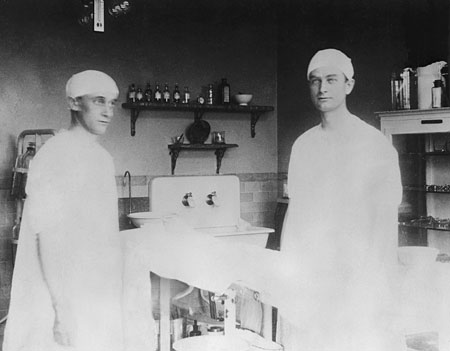
Often the patients at Mayo Clinic are seeking last chance and novel treatments. Pushing the boundaries of what is possible requires significant financial risk to any organization. Research and development in any form is rife with unforeseeable costs, not to mention the stakes involved with medicine. Mayo Clinic has specialists who analyze the benefits of these risks, and not become fixated on just costs. An example is proton beam radiation therapy. Though more expensive than conventional radiation, the cost to the patient for this service at Mayo is similar to x-ray therapy so there is not a financial barrier to receiving the most appropriate treatment.
In this way, the entirety of operations at Mayo Clinic is the result of grand collaboration. Therefore, collaboration is an essential element to anyone who wishes to emulate Mayo Clinic and its success in any way.
As the head of business activity for my own organization, and with 30-plus years ahead of me, I look to figures such as Dr. W.W. Mayo and his sons as a beacon.
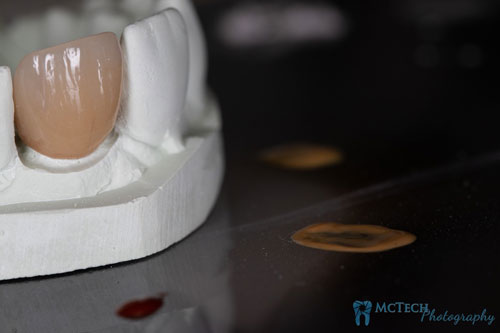
Afterword
I can think of several instances where an emergency situation in a doctor’s office required immediate and full collaboration from my father. One such case was with a patient of a local doctor. Her case involved two three-unit bridges, one posterior and the other anterior along with two single units. This was a challenging patient for several reasons, including severe anxiety that required sedation. After the patient was sedated and the temporaries removed, it was discovered the tissue had receded and required re-prepping and re-imprisoning. My father was called; given the time table, he said he could adapt the restorations in the limited amount of remaining sedation. The clinician and technician were now committed. We received the case quickly, poured up the impression into a working model, a solid model, and another pour up for extra dies. He added the porcelain to fit the new margins, adapted the pontics to the new position of the tissue, and double-checked form, function, and contacts. He finished the posterior, handed it to me to deliver and started on the anterior. By the time I got back, he was handing me the anterior and I rushed back to drop it off. It took most of the morning, but by noon that day the patient was awake and happy with her restorations (and my father was able to start on the cases already scheduled that day). Is this case comparable to a tornado? Will this instance go on to change history? No, but ask a doctor what such a situation feels like and he or she may very well use the term tornado.
It should be noted by this example that the true measure of quality is not what one is capable of in the best circumstance. Rather, it depends upon what each of us is willing to accept during the worst of circumstances. Rising to such a challenge is the best way to serve patients while finding personal and professional fulfillment.
Sources:
Ken Burns and the Ewers Brothers: The Mayo Clinic: Faith—Hope—Science. https://www.pbs.org/kenburns/the-mayo-clinic/
Mayo Clinic History and Heritage Website
Author: Matthew D. Dacy
Url: http://history.mayoclinic.org/
Access Date January 27, 2020
The Little Book of Mayo Clinic Values: A field Guide for Your Journey
Authors: Sister Ellen Whelan, Ph.D., and Matthew D. Dacy
Publisher: 2017 Mayo Foundation for Medical Education and Research; second printing, 2019.
Url: http://history.mayoclinic.org/impact/mayo-clinic-values.php
PDF: http://mccms.cws.net/content/history.mayoclinic.org/files/MC-Values%20Book%20full-2019.pdf
Access Date January 27, 2020
Photo Credits
Mayo Clinic / Mayo Foundation for Medical Education and Research; Rochester, Minnesota

